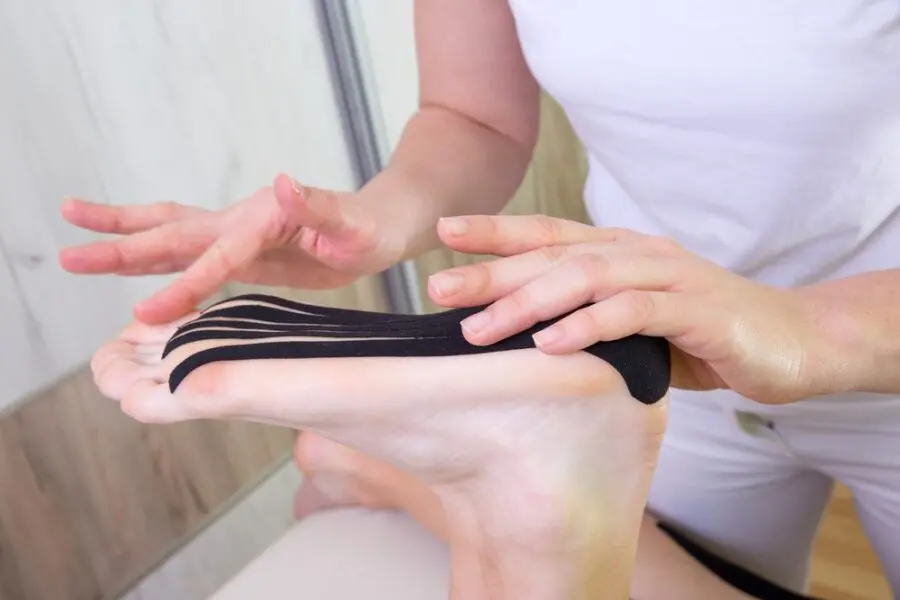
Therapeutic taping consists of adhesive bandage that is strategically applied to specific areas in order to increase muscle tone or reduce pain associated with certain movements. Contrary to popular belief, therapeutic taping helps more than just for athletes.
While its use is widespread among runners and tennis players, therapeutic taping is also suitable for the general population. It is efficient for relieving very specific joint and muscle pain, however therapeutic taping cannot be applied just anywhere at random.
That’s why it’s important to trust a qualified professional such as a podiatrist to perform the taping. If you have been struggling with muscle pain or tension for some time, therapeutic taping may be right for you.
The different types of therapeutic taping
Taping is often used in addition to physiotherapy and plays a therapeutic role for many people.
This comes in 3 types: athletic taping, neuro-proprioceptive taping and finally therapeutic or compressive taping.
Each type has a very specific function.
Athletic taping
The athletic taping is the most common of them all, made with a white band. This type of taping is mainly used to limit or direct the foot’s movements that could aggravate a muscle or joint injury such as a sprain.
It can also be used during rehabilitation when the athlete gradually resumes activity.
Neuro-proprioceptive taping
Neuro-proprioceptive taping is used to promote muscle development and is less restrictive than athletic taping. This type of taping helps to reduce inflammation in the foot as well as mitigate pain stemming from the injury.
Therapeutic taping
Therapeutic taping consists of several layers of tape and aims to reduce tension in certain joints and structures.
For example, it can act on the foot’s muscles or ligaments.
This form of taping also affects the biomechanics and body posture.
Benefits of therapeutic taping
Taping offers a variety of therapeutic possibilities, which make it a versatile treatment for musculoskeletal pathologies or injuries.
These benefits include:
- A faster healing process
- Reduced muscle or joint pain
- The ability to invigorate muscles that are losing strength
- Decreased muscle tension in the foot and leg
- Effective correction of joint malpositions
- Shortened recovery time after prolonged exertion.
What can you treat with therapeutic taping?
As we have discovered, therapeutic taping is not exclusive to athletic activity.
This treatment has both preventive and corrective functions.
Here is what taping helps to treat:
- Lower back pain
- Plantar fasciitis
- Tension in the muscles
- Temporary joint instability such as a sprained foot
- Weakness of the musculature
- Heel spur
- A contusion or muscle strain
- Painful muscle spasms
- Shin splints
- Joint swelling
- Achilles tendinitis
- Loss of muscle tone after surgery
- Postural or biomechanical problems
If your symptoms are ligament, muscle, or joint related and you are seeking therapeutic taping treatment, it is important to consult a professional.
The process of applying therapeutic taping
A diagnosis must be made by your treating podiatrist before any taping is applied.
To this end, they may require you to undergo a postural assessment or a biomechanical exam.
Once they have established the source of the injury and the patient’s medical history, the podiatrist will assign the most appropriate type of taping.
Seeing as taping is used to treat many injuries, there are several techniques that can be used in its application.
But in more general terms, the podiatrist will usually prefer this process:
- The attending doctor measures and cuts the strips that will be used for taping
- The patient is asked to get into a position that facilitates the podiatrist’s procedure
- A first adhesive strip is applied with slight pressure to the target area
- A second strip is applied
- The podiatrist performs their manipulations directly on the affected region to achieve the desired pressure
- If necessary, further adhesive strips complete the dressing
- The patient is asked to adjust their position to promote a natural tension of the taping if required
Therapeutic taping can be kept for 5 days, if there is no allergy.
Additional treatments
Seeing as therapeutic taping has many advantages and is easy to administer, it is often combined with other treatments, such as:
- Manual foot therapy, which mobilizes the joints of the foot through gentle manipulation
- A custom exercise and stretching program
- Physiotherapy
- Foot orthoses, for example, can mitigate the recurrence of plantar fasciitis
Therapeutic taping – the first resort treatment for foot injuries
Entrusting the relief of muscle pain to simple colored adhesive strips may seem counterintuitive.
However, therapeutic taping is a proven way to treat injuries such as plantar fasciitis or Achilles tendinitis.
Mind you, applying the taping requires a professional technique, which can be provided by a podiatrist.
To learn more about the therapeutic taping treatment, contact your PiedReseau clinic today.